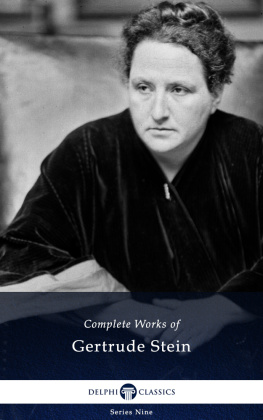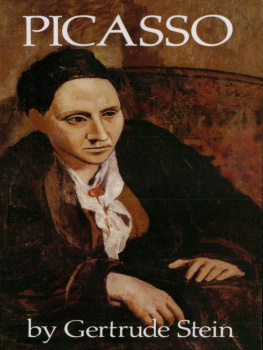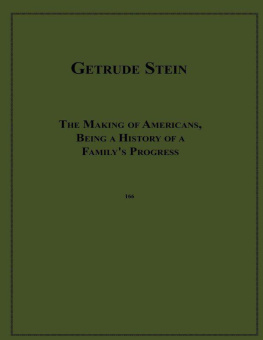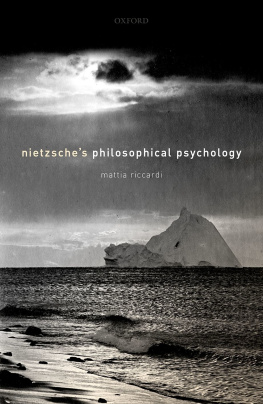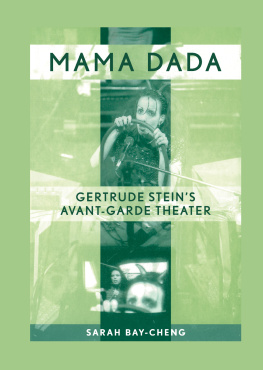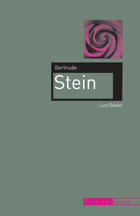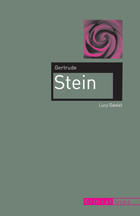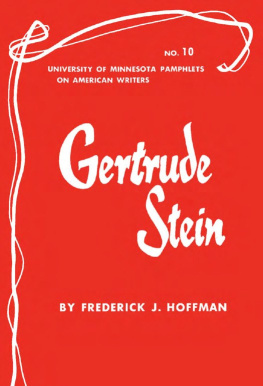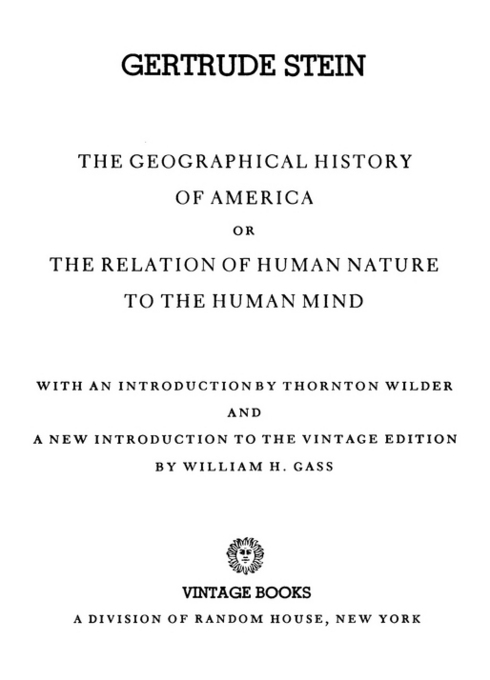First Vintage Books Edition, October 1973
Copyright 1936 by Random House, Inc.
Introduction Copyright 1973 by William H. Gass
All rights reserved under International and Pan-American Copyright Conventions. Published in the United States by Random House, Inc., New York, and simultaneously in Canada by Random House of Canada Limited, Toronto. Originally published by Random House, Inc., in 1936.
Library of Congress Cataloging in Publication Data
Stein, Gertrude, 18741946.
The geographical history of America.
With a new introd. by W. H. Gass.
I. Title.
PS 3537 .TG 1973 818.5207 73-9641
eISBN: 978-0-307-82443-1
v3.1
Contents
O THER B OOKS BY G ERTRUDE S TEIN IN V INTAGE
EVERYBODYS AUTOBIOGRAPHY
IDA
THE AUTOBIOGRAPHY OF ALICE B. TOKLAS
THREE LIVES
SELECTED WRITINGS OF GERTRUDE STEIN ( CARL VAN VECHTEN, ED .)
INTRODUCTION TO THE VINTAGE EDITION
BY WILLIAM H. GASS
1
W hen Gertrude Stein was a young girl, the twentieth century was approaching like a distant train whose hoot you could only just hear. A whole age was about to end. Nations would rededicate themselves, an entire generation bite into a fresh loaf, turn over a new leaf tremble, pray. Despite this threat from the realm of number, though, most of the world went on as before, repeating itself over and over in every place, beginning and rebeginning, again and again and again.
Kipling had just written The Phantom Rickshaw. Stevenson was about to bring out The Master of Ballantrae, Howells to publish A Hazard of New Fortunes, while recently young Miss Stein had composed a melodrama called Snatched from Death, or the Sundered Sisters.
Henry James had also been busy. The Bostonians and The Princess Casamassima appeared in the same year, almost moments ago, it must have seemed, and Scribners Magazine was now serializing A London Life. Writing machines were prominently advertised in the same periodical, as well as a restorative medicine made of cocainized beef, wine, and iron, said to be invaluable for nervous prostration, brain exhaustion, cases of the opium, tobacco, alcohol or chloral habit, gastric catarrh, and weak states of the voice or generative systems, among other things. Indeed, women were frequently in need of similar elixirs to combat depressions of the spirit, neurasthenia, sick headache, dyspepsia, and loss of appetite. Adelina Patti was recommending Pears Soap. There were several new developments among stoves. Lew Wallace, Dr. Abbott, Motleys Works, Walter Besants novels, Charles Dudley Warner, Rider Haggard, and a series labeled The English Men of Letters were being smartly puffed, as well as the stories of Constance Fenimore Woolson and an edifying volume by Charles Reade called Bible Characters (12 mo, cloth, 75 cents).
At Gettysburg, on the twenty-fifth anniversary of the battle, George Parsons Lathrop read a very long commemorative ode.
And, with a movement magnificent,
Pickett, the golden-haired leader,
Thousands and thousands flings onward, as if he sent
Merely a meek interceder.
And at the great Paris Exposition, among the Americans represented, Thomas Hovenden showed his picture, The Last Moments of John Brown, of which one critic said: It is easy to believe that we are looking at a faithful transcript of the actual scene, and that photography itself could not have made a more accurate record. It is the best American painting yet produced, wrote another. Holloways reading stand was deemed particularly good for ladies, combining a book rest, dictionary holder, lamp stand, and invalids table. It was sold where made in Cuyahoga Falls, Ohio.
For some time Gertrude Stein had been absorbed, she claimed, in Shakespeare (of course), and in Wordsworth (the long dull late and densely moral poems particularly), Scotts wonderful Waverley, Burns, Bunyan, Crabbe, in Carlyles Frederick the Great, Fielding, Smollett, and even Leckys formidable Constitutional History of Englandworks of the sort Id cite, too, if I were asked. Prognostications of doom were also common, and increasing. Arks were readied, mountaintops sought out. Number for some was still number: a mark on a tube was magical a circled day a scratch on a tree layer in a rock. The International Date Line runs like a wall through the ocean.
We can only guess whether the calendar had any influence on her, although later no one was to champion the new century more wholeheartedly, or attempt to identify America with modernity. The United States was the oldest country in the world, she said, because it had been in the twentieth century longer. In any case, Gertrude Stein, at age fifteen, thought frequently of death and change and time. Young girls can. She did not think about dying, which is disagreeable, even to young girls, but about death, which is luxurious, like a hot soak. The thought would appear as suddenly as moist grass in the morning, very gently, often after reading, on long reflective walks; and although it distressed her to think that there were civilizations which had perished altogether, she applauded the approaching turn. It was mostly a matter of making room. I was there to begin to kill what was not dead, the nineteenth century which was so sure of evolution and prayers, and esperanto and their ideas, she said. It would be a closing, as the opening of puberty had been. A lid. Her own ending, even, did not disturb her. Dissolution didcoming apart at the seamsand she had, as many do, early fears of madness, especially after reading The Cenci or attending a performance of Dr. Jekyll and Mr. Hyde. She held little orgies of eating, liked to think and read of revolutions, imagined cruelties. She consumed anything, everything, as we have seen, and then complained that there was Nothing but myself to feed my own eager self, nothing given to me but musty books.
Scribners Magazine was serializing A London Life. It contained plot, customs, characters, moral issues, insight, endless analysis, a little description, and went over its chosen ground often like an elephant in mittens. There was another of those essays on the decline of the drama in a recent Harpers. This one was quite decent really, by Brander Matthews, and in it he argued that one reason for the apparent death of the drama was the life of the novelthe present art form of the publicin particular, the immense early success of Scotts Waverley novels. Scribners July issue of 1888 catches up A London Life at the beginning of Chapter V:
And are you telling me the perfect truth when you say that Captain Crispin was not there?
The perfect truth? Mrs. Berrington straightened herself to her height, threw back her head and measured her interlocutress up and down; this was one of the many ways in which it is to be surmised that she knew she looked very handsome indeed. Her interlocutress was her sister, and even in a discussion with a person long since under the charm she was not incapable of feeling that her beauty was a new advantage.
In Composition as Explanation Gertrude Stein would argue that between generations and over time, the only thing different is what is seen and what is seen depends upon how everybody is doing everything. Everything is the same except composition.


